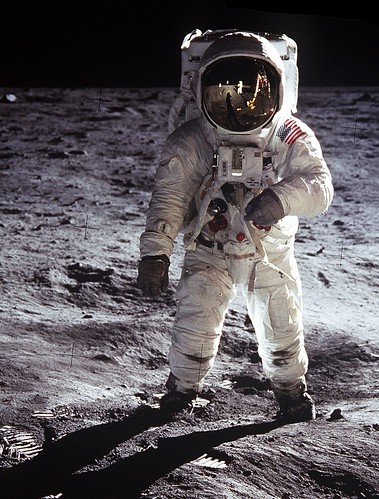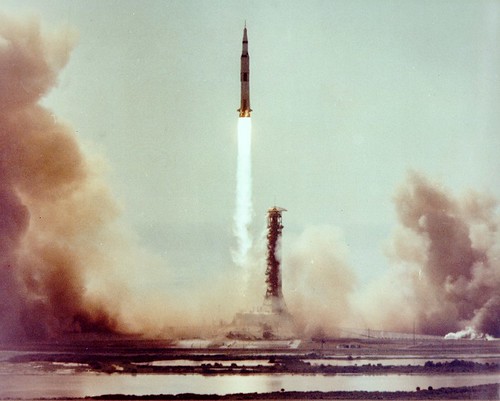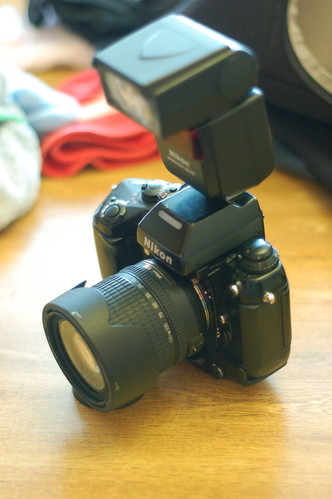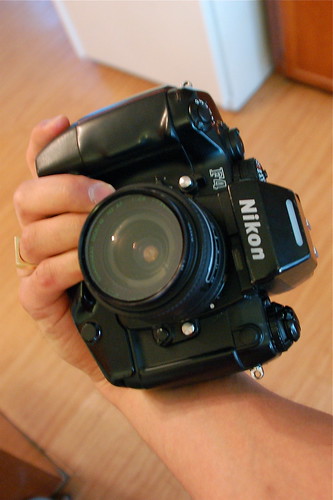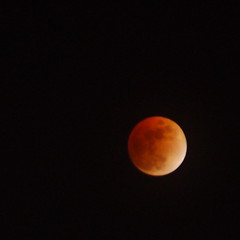Penmachine
15 March 2010
Studying for jobs that don't exist yet
After high school, there are any number of specialized programs you can follow that have an obvious result: training as an electrician, construction worker, chef, mechanic, dental hygienist, and so on; law school, medical school, architecture school, teacher college, engineering, library studies, counselling psychology, and other dedicated fields of study at university; and many others.
But I don't think most people who get a high school diploma really know very well what they want to do after that. I certainly didn't. And it's just as well.
At the turn of the 1990s, I spent two years as student-elected representative to the Board of Governors of the University of British Columbia, which let me get to know some fairly high mucky-muck types in B.C., including judges, business tycoons, former politicians, honourees of the Order of Canada, and of course high-ranking academics. One of those was the President of UBC at the time, Dr. David Strangway.
In the early '70s, before becoming an academic administrator, he had been Chief of the Geophysics Branch for NASA during the Apollo missions—he was the guy in charge of the geophysical studies U.S. astronauts performed on the Moon, and the rocks they brought back. And Dr. Strangway told me something important, which I've remembered ever since and have repeated to many people over the past couple of decades.
That is, when he got his physics and biology degree in 1956 (a year before Sputnik), no one seriously thought we'd be going to the Moon. Certainly not within 15 years, or probably anytime within Strangway's career as a geophysicist. So, he said to me, when he was in school, he could not possibly have known what his job would be, because NASA, and the entire human space program, didn't exist yet.
In a much less grandiose and important fashion, my experience proved him right. Here I am writing for the Web (for free in this case), and that's also what I've been doing for a living, more or less, since around 1997. Yet when I got my university degree (in marine biology, by the way) in 1990, the Web hadn't been invented. I saw writing and editing in my future, sure, since it had been—and remains—one of my main hobbies, but how could I know I'd be a web guy when there was no Web?
The best education prepares you for careers and avocations that don't yet exist, and perhaps haven't been conceived by anyone. Because of Dr. Strangway's story, and my own, I've always told people, and advised my daughters, to study what they find interesting, whatever they feel compelled to work hard at. They may not end up in that field—I'm no marine biologist—but they might also be ready for something entirely new.
They might even be the ones to create those new things to start with.
Labels: biology, education, memories, moon, school, science, vancouver, work
24 July 2009
Splashdown
Today we mark 40 years since the Apollo 11 Command Module Columbia splashed down in the middle of the Pacific Ocean, a few hundred kilometres from the now-closed Johnston Island naval base:
Our first (and sixth last!) trip to the surface of the Moon was over. The seared, beaten Columbia (weighing less than 6,000 kg, and which had remained shiny and pristine until its re-entry into the Earth's atmosphere), with its passengers, was the only part of the titanic Saturn V rocket (3 million kg) to return home after a little over one week away. Every other component had been designed to burn up during launch or return, to stay on the Moon's surface (where those parts remain), to smash into the Moon, or to drift in its own orbit around the Sun.
All three astronauts returned safely, and suffered no ill effects, despite being quarantined for two and a half weeks, until August 10, 1969, when I was six weeks old.
Labels: anniversary, astronomy, holiday, moon, oceans, science, space
21 July 2009
Going home
Just before noon today, Pacific Time, marks exactly 40 years since Neil armstrong and Buzz Aldrin launched their Lunar Module Eagle and left the surface of the Moon, to rendezvous with their colleague Michael Collins in lunar orbit:
They were on their way home to Earth, though it would take a few days to get back here.
Labels: anniversary, astronomy, holiday, moon, science, space
20 July 2009
Today was the day
The beginnings of human calendars are arbitrary. We're using a Christian one right now, though the start date is probably wrong, and the monks who created it didn't assign a Year Zero. Chinese, Mayan, Hindu, Jewish, Muslim, and other calendars begin on different dates.
If we were to decide to start over with a new Year Zero, I think the choice would be easy. The dividing line would be 40 years ago today, what we call July 16, 1969. That's when the first humans—the first creatures from Earth of any kind, since life began here a few billion years ago—walked on another world, our own Moon:
They landed their vehicle, the ungainly Eagle, at 1:17 p.m. Pacific Daylight Time (the time of my post here). Just before 8 PDT, Neil Armstrong put his boot on the soil. That was the moment. All three of the men who went there, Armstrong, Buzz Aldrin, and Michael Collins, are almost 80 now, but they are still alive, like the rest of the relatively small slice of humanity that was here when it happened (I was three weeks old).
If the sky is clear tonight, look up carefully for the Moon: it's just a sliver right now. Although it's our closest neighbour in space, you can cover it up with your thumb. People have been there, and when the Apollo astronauts walked on its dust, they could look up and cover the Earth with a gesture too—the place where everyone except themselves had ever lived and died. Every other achievement, every great undertaking, every pointless war—all fought over something that could be blotted out with a thumb.
Even if it doesn't start a new calendar (not yet), today should at least be a holiday, to commemorate the event, the most amazing and important thing we've ever done. Make it one yourself, and remember. Today was the day.
Labels: anniversary, astronomy, holiday, moon, science, space
16 July 2009
Launch day
Forty years ago today. July 16, 1969, 9:32 a.m. EDT, Launch Complex 39A, Cape Canaveral, Florida. Three nearly hairless apes—human beings in pressure suits—left for the Moon:
They were aboard the world's greatest machine, which put out about 175 million horsepower during launch. Less than three hours later, they exited Earth orbit and were on their way.
Labels: anniversary, astronomy, moon, science, space
05 July 2009
Links of interest 2006-06-28 to 2006-07-04
Once again, while I'm on my blog break, my edited Twitter posts from the past week, newest first:
- Photo of Obama picking up his infamous housefly victim.
- Guess that U2 iPod is never coming back.
- And now: "Ant and Buttercup," my debut HD macro closeup movie from our summer garden:
- My first experiments with off-camera flash during close-up photography:










- If I'm passed at high speed by someone with a Washington plate BOKEH, I now know who it is. He says he'll wave.
- Mammals will play, even between species, even when you'd never expect it—wild polar bear and huskies (slide show via Dave Winer).
- A couple of crows are nesting nearby; they keep landing in our birdbath and on the house and lamp stands, looking ominous. Too smart, crows.
- Sitting in a B.C. garden
No waiting for the sun - CompuServe finally shuts down.
- Just in case you're looking for a $2.1 million convertible.
- Congratulations to Buzz Bishop, Jen, and Zacharie.
- I presume this tiny USB-driven monitor screen is Windows-only, because of drivers? Looks pretty swell. (Via Neal Campbell.)
- Definitive proof I'm not afraid of heights: I love this idea.
- Via John Biehler, I found that as well as MythBuster Adam Savage, his co-workers Grant Imahara and narrator Robert Lee are also on Twitter.
- When I had my first Nikon 25 years ago, I wouldn't have believed I'd ever own one (a D90) with 66 pages of the manual (out of a couple hundred total, in a 16 MB PDF file) just for menu options. Then again, 25 years ago, a friend showed me a shoulder-mounted Betamax camera from Hong Kong, and it was the latest in high tech video too.
- That's the funkiest beat I've ever heard a marching band play (via Jared Spool). Maybe some James Brown next?
- Has anyone pinpointed the exact day that Victoria Beckham stopped being able to smile? Angus Wilson speculates, "whatever day she began to look less like a hot English babe and more like a velociraptor."
- Meg Fowler: "Sarah Palin's quitting politics like Ann Coulter's quitting evil."
- As the 40th anniversary of the first moon landing approaches, some fabulous photos from the missions, via Bad Astronomy.
- From Ben Englert: "Thank you, gdgt, for institutionalizing the arduous task of dick-measuring by figuring out who has more toys."
- Ten best uses of classical music in classic cartoons.
- Our fridge magnet: "I love not camping."
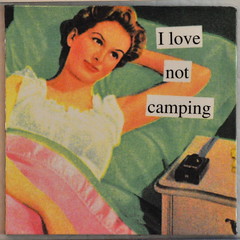
- How did I manage to bite the inside of my upper lip while eating a peach? If this were high school, the guys would say, "Each much?"
- Back to short hair for summer. And now I realize that it's Colbert hair.
- I think my guts have calmed down now. Time for bed. In the meantime, enjoy a naked Air New Zealand flight crew.
- In case you'd like to watch Jeff Goldblum reporting on his own "death," on Colbert Monday: links for Canada and the U.S.A. (sorry if you're elsewhere!).
- Didn't attend various Canada Day parties because of tired family and my usual intestinal side effects. Hope you had fun in my stead. Managed to avoid intestinal chemo side effects for a few days, but they're back with a vengeance. Could be a looooong night. (And it was. At 2 a.m., my chemo side effects were "over" and I went to bed. Bzzt! Wrong! Finally got to sleep at 9 a.m., woke up at 1 the next afternoon. As Alfred E. Neuman says, Yecch.)
- Whatever you think of the 2010 Olympics here in Vancouver, VANOC is doing a good job with graphic design.
- I, too, welcome our new ant overlords.
- I had no alcohol on my birthday yesterday, but still had a Canada Day headache on July 1. Here's my new free instrumental.
- Inside Home Recording #72 is out: Winners, Studio Move, Synth 101, Suckage! AAC enhanced and MP3 audio-only versions.
- Normally I really like our car dealer's service dept, but today the steering wheel came back oh-so-slightly to the left. They had to re-fix it.
- World's geekiest pillows (via Chris Pirillo). My guess: they didn't license the Apple icons. Get the pillows while you can.
- Officially made it to 40. Thanks everybody for the birthday wishes. Most people are bit melancholy to reach 40, but I am extremely glad to have made it.
- Just returned from a Deluxe Chuck Wagon burger (with cheese) at the resurrected Wally's Burgers in Cates Park, North Vancouver:
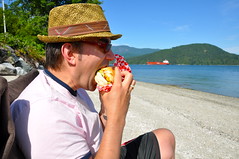
- From Rob Cottingham: "The hell with putting a ring on it. If you liked it, you shoulda made a secure offsite backup."
- Info about recording old vinyl records into a computer: You need a proper grounded phono preamp, with good hot signals into an audio interface or other analog-to-digital converter. A new needle might be wise if yours is old, but the real phono preamp (w/RIAA curve) is the most necessary bit after that. Route it thru an old stereo tuner if needed! See my old post from 2006 at Inside Home Recording.
- Myth confirmed: Baby girl evidence (named Stella) shows MythBusters' Kari Byron actually was pregnant.
- My new Twitter background image is the view we saw at sunset during my birthday party on Saturday. (I've since replaced it again.)
- Back from another fun sunny summer BBQ at Paul Garay's new house—it's been a burgers-n-beer weekend.
- Photos from my 40th birthday party now posted (please use tag "penmachinebirthday" if you post some).
Labels: animals, band, birthday, cartoon, family, food, geekery, insidehomerecording, linksofinterest, moon, movie, music, mythbusters, news, paulgaray, photography, politics, space, transportation, usb
14 November 2008
Today, it's Japan, China, and India at the Moon
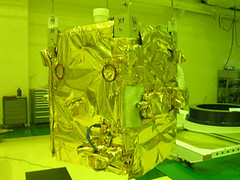 Remember when the U.S. and Russia were the only countries with space programs and their own rockets? Then came the European Space Agency, mostly launching commercial satellites from French Guyana. Somehow my 1970s kid brain is still stuck in that mindset.
Remember when the U.S. and Russia were the only countries with space programs and their own rockets? Then came the European Space Agency, mostly launching commercial satellites from French Guyana. Somehow my 1970s kid brain is still stuck in that mindset.
But it's wrong, wrong, wrong. Yes, the U.S. still sends plenty of astronauts into orbit, and has wonderful robotic probes venturing throughout the solar system. But how about the Moon? As far as I can tell, the last time America sent anything to the Moon was ten years ago, when the Lunar Prospector orbited, then intentionally crashed into a crater to test for water. Russia hasn't sent anything since the Luna 24 probe in 1976. The ESA was there more recently, with its SMART 1 five years ago.
Who is sending spacecraft to the Moon now? That would be Japan, China, and (most notably today) India, which hit the moon with a flag-painted impact probe sent from its Chandrayaan-1 lunar orbiter mere hours ago.
The U.S. has a lunar orbiter scheduled to launch next year, and both it and Russia have grand plans to send people back, but for now, it is the countries of Asia that are telling us about our nearest neighbour in space. I think that's pretty cool.
Labels: astronomy, geekery, moon, politics, science, space
28 September 2008
The world's greatest machines
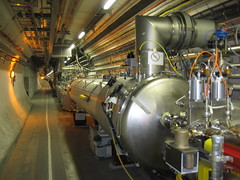 There's been a lot of talk recently about how the Large Hadron Collider (LHC) is the largest and most powerful machine ever built. I guess it is that. But there is another machine I still like better: the Apollo Saturn V moon rocket, retired more than 35 years ago. Each one was constructed not for years and years of experiments by thousands of people, as the LHC is, but for a single task lasting a mere week: to get three men to the moon and back.
There's been a lot of talk recently about how the Large Hadron Collider (LHC) is the largest and most powerful machine ever built. I guess it is that. But there is another machine I still like better: the Apollo Saturn V moon rocket, retired more than 35 years ago. Each one was constructed not for years and years of experiments by thousands of people, as the LHC is, but for a single task lasting a mere week: to get three men to the moon and back.
The Saturn V was the most powerful machine of its time. I still think it is the most important device we've ever built, and as far as I know it remains the most expensive—in adjusted dollars, the Apollo program cost about $135 billion, many times the price of the LHC.
 I've just watched In the Shadow of the Moon again, this time on television. (It was worth seeing in the movie theatre before, for the size of the images.) I was less than three weeks old during the launch and the eventual landing of the Lunar Module. If I'd been an adult, I think I would have burst into tears at both events. I've come pretty close just watching the footage, almost 40 years later.
I've just watched In the Shadow of the Moon again, this time on television. (It was worth seeing in the movie theatre before, for the size of the images.) I was less than three weeks old during the launch and the eventual landing of the Lunar Module. If I'd been an adult, I think I would have burst into tears at both events. I've come pretty close just watching the footage, almost 40 years later.
I'm very happy that people think basic physics important enough to spend billions of dollars constructing the LHC. But, while it is impressive, that device is an experimental apparatus, carefully assembled over many years. Although the Apollo rockets were also a massive endeavour, it happened instead in an astounding rush, a little over eight years from conception to success, less time than it takes for Peter Gabriel to make a new album. It remains the only time we've taken people to another world. That's some really awesome machinery.
Labels: astronomy, moon, movie, science, space
26 September 2008
Eternal sunshine
This is pretty cool: there are a couple of high spots at the moon's south pole (one a mountain, one the rim of a crater) where the sun never sets. Ever.
Labels: astronomy, moon, science
09 July 2008
The monster film camera arrives
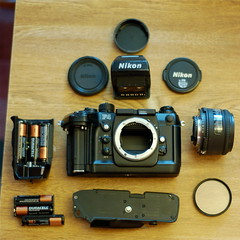 Yesterday I got an online notice that my eBay purchase Nikon F4 film camera had cleared Canada Customs. I thought that might mean it would take a few more days to arrive, but the Canada Post truck showed up with it this afternoon. I made some camera nerd unboxing photos with my digital SLR if you'd like to see them.
Yesterday I got an online notice that my eBay purchase Nikon F4 film camera had cleared Canada Customs. I thought that might mean it would take a few more days to arrive, but the Canada Post truck showed up with it this afternoon. I made some camera nerd unboxing photos with my digital SLR if you'd like to see them.
I have to say this: wow. For a 20-year-old design, the F4 is an amazing camera. It weighs a ton, because it's both huge (freakin' huge) and made of thick metal under the rubber covering, but it feels great in my hands. It's remarkably responsive, easy to figure out for anyone who grew up with the dials, knobs, and buttons of an analog SLR, and fast.
I'd also forgotten what it's like to look into a bright, full-frame, 100%-coverage viewfinder with minimal clutter. Compared to the finder view in my D50, it's expansive, and having only one central autofocus point plus a couple of etched circles (to show where the different types of light metering act) means there's a lot less other stuff busying up the view.
All my Nikon-mount lenses fit and work—even ones with technology designed more than a decade after the camera ceased production—although the newest, designed for a smaller digital sensor and lacking an aperture ring, is limited and vignettes heavily. Most surprising, my SB-600 flash functions pretty much fully, including reading lens focal length, working with through-the-lens (TTL) metering, and acting as an autofocus illuminator (which the camera otherwise lacks).
Running the motor drive at top speed yields a full paparazzi kssht-kssht-kssht-kssht-kssht, much faster than my lower-end D50 digital SLR from 2006. Autofocus is surprisingly quick too, though not up to complete modern standards. Unlike my D50, the F4 has mirror lockup, dedicated buttons for exposure and focus lock, depth of field preview, and an eyepiece shutter on a removable viewfinder pentaprism.
I loaded the F4 up with some Ilford black-and-white film and took it along while my younger daughter and I walked to the store and the park this sunny afternoon. I also picked up a new camera strap at Kerrisdale Cameras, since none of my current ones have the keychain-style metal rings at the ends that work with the F4's teeny tiny metal strap connectors. And I'll have to track down a rubber eyepiece ring, since that's the only stock item missing from the camera.
Of course, the key frustration with any film camera is that you can't see your pictures right away—I'll have to wait to finish the roll and get it processed, just like I did my entire picture-taking life from childhood until I bought my first digital camera in 2002. And yet that also forces me to think a bit more: How will this look in black and white (for this roll)? What's the best angle for this shot (I can't waste film trying a bunch of different ones)? What works in this light at this film ISO setting (since I can't adjust that)? What kind of depth of field and shutter speed do I want? And so on.
Perhaps the greatest pleasure comes from something I haven't had in more than 15 years: an SLR camera with analog controls for every feature, not multifunction digital buttons and mode dials and four-way controllers and LCD screens. Other than the lack of a manual film winding lever, and the info LCD inside the viewfinder, the F4 has the same kind of excellent tactile controls and analog displays photographers relied on for decades, from the first Leica rangefinder shooters to the astronauts walking on the moon.
There's definitely a difference adjusting the lens opening with an aperture ring on the lens, and the shutter speed with a dedicated dial on the top of the camera, than with the one or two thumbwheels on the handgrips of modern digital (and even film) SLRs. In the digital era, only the otherwise imperfect Panasonic Lumix DMC-L1 and Leica M8, with their retro aesthetic, offer anything like that.
Obviously, I don't have any of my photos from the F4 yet. But I'll link them up when I do.
Labels: film, gadgets, geekery, leica, moon, nikon, photography
20 February 2008
Lunar eclipse photos from Vancouver
In Vancouver, the clouds cleared just long enough for some beautiful views of the lunar eclipse. I got some nice pictures (and so did my dad):
Mine were taken with a Nikon D50 camera on a tripod, and attached to a Sigma/Quantaray 70-210 mm zoom lens set at f/5.6, ISO 800, exposures generally between a half-second and two seconds. My dad took his with a Canon Digital Rebel XT attached to a Celestron C90 reflector telescope on a tripod, acting as a 1000 mm f/11 lens, with similar exposure times and ISO settings.
Labels: americas, astronomy, eclipse, moon, photography, science, vancouver



